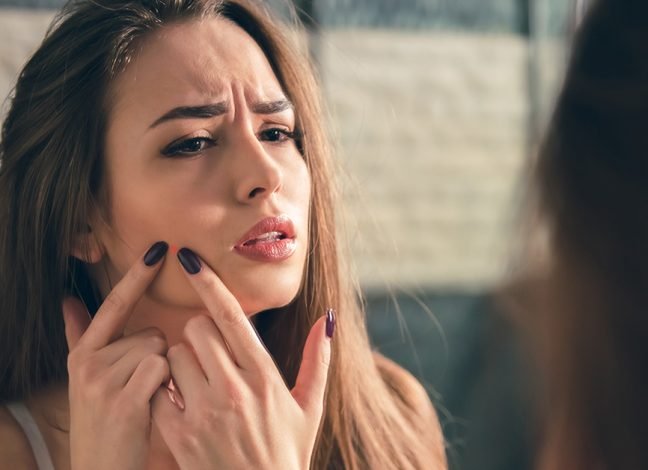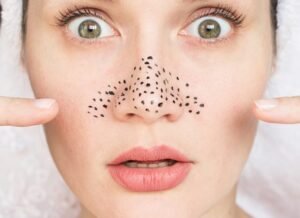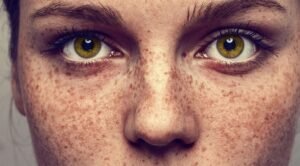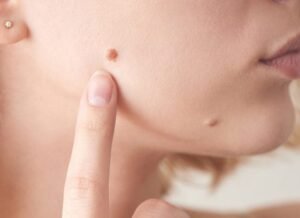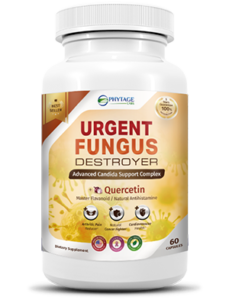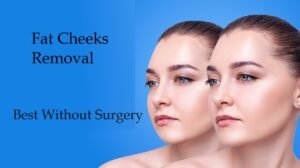There are so many things you love about yourself. You love your hair. You love your sense of style. You get ready in the morning, check yourself out in the mirror, and you know you look poppin’.
You step closer to the mirror to check out your gorgeous face, and there it is. The thing that has been sent to ruin your day and shatter your self-confidence.
You hate your acne. Pimples always seem to pop up right when you need them the least.
They make you want to scream, WHY? All you want to do is get the thing off your face and return to feeling great about yourself.
In this article, we’ve compiled some ways for you to get rid of pimples and help you control your acne. We’ve included all kinds of methods, from prescription medications to at-home remedies to all-natural solutions.
Keep reading to figure out how to banish your pimples and get back to loving yourself.
Where Does Acne Come From?
First off, it helps to understand where exactly acne comes from. Everyone’s skin contains teeny tiny holes called pores. These pores connect to oil glands and hair follicles that sit under the sin.
According to the National Institute of Arthritis and Musculoskeletal and Skin Diseases, your glands can create an oily substance called sebum, and that’s where our problems begin.
See, your pores connect to the oil glands via a hair follicle. Everyday oil carries dead skin cells up along this follicle and out on to the surface of your skin. This process is normal and is essential to healthy skin.
According to the American Academy of Dermatology, your skin gets rid of 30,000-40,000 skin cells every day, and your skin will completely replenish itself about once a month.
Sometimes, though, as the oil carries those dead skin cells to the surface, the oil and skin cells and hair will get all clumped together in the follicle. Together they form a “plug.” Bacteria begin to grow in the plug which can cause the plug to grow and swell.
When the plug starts to break down, a pimple will form on the surface of the skin.
Types Of Acne
You’ve probably noticed by now that there are lots of types of acne that can pop up on your face. Sometimes it seems like pimples come in every color of the rainbow.
The type of acne popping up on your face can tell you a lot about what’s going on beneath the surface of your skin. You will also want to treat each type of pimple a little differently.
According to Medical News Today, there are six major types of acne. Here are some common types of acne, and how they form on your face.
Whiteheads
Whiteheads are small bumps that usually appear to be white or are flesh-toned. A small ring of white skin often surrounds a whitehead.
Whiteheads form along a hair follicle, so it is totally normal to see a hair emerge from a whitehead. The skin around a whitehead can be tight or sometimes even wrinkled, depending on the severity of the whitehead.
Blackheads
Blackheads are basically whiteheads that have opened up and expanded on the surface of the skin. Just as the name describes, they will appear black. This black color is not dirt.
What’s happening is the bacteria and oils in a whitehead get darker when exposed to air. The major difference between blackheads and whiteheads is simply whether or not the bacteria have been exposed to air.
Papules
Papules form when whiteheads or blackheads cause extreme irritation on the surrounding skin. The skin becomes inflamed and bumps form under the surface of the skin.
Papules are usually red or pink and can be painful or sensitive to touch. Unlike whiteheads or blackheads, papules do not have a discernable center.
Pustules
Pustules look a lot like whiteheads but are usually bigger, more solid, and more painful. Pustules are a bump on the surface of the skin that is red and swollen but also has a discernable white center.
Typically, yellow or white pus fills the center of the pustule. The pus is made up of a collection of bacteria and immune cells.
Nodules
Nodules form deep inside your skin. They may look a bit like papules, but they are larger, deeper, and more painful.
These hard little bumps form when surface acne becomes so serious that it causes damage to the deeper tissues and cells under the skin’s surface. Nodules are much more severe than any of the other acne types we’ve listed so far.
Cysts
The last type of acne is a cyst. Cysts are similar to nodules but form much deeper within the skin. Unlike nodules, cysts are soft and can be white, red, or flesh-toned. Cysts are typically very painful and quite large.
If a cyst becomes infected, it may continue to grow in size. Cysts are the most serious type of acne you might experience.
Different Skin Types
Critical to preventing acne is trying to avoid any product or activity that may irritate your skin. Everyone’s skin is a little different, so what may irritate your skin may not irritate your best friend’s.
In fact, according to Women’s Health Magazine, there are a few different skin types you should be aware of before you try and treat your acne.
Oily
You know you might have oily skin if your skin is shiny or moist on the surface. The skin’s oils tend to peak around midday, so you may notice that your skin is shiniest around lunchtime.
Those with oily skin are more likely to experience acne because the oil in their pores is more readily available. It can easily get clogged in your follicles and grow infected.
Dry
Dry skin is quite the opposite of oily. Your skin may feel tight or rough. Those with dry skin are prone to rashes and may even experience eczema. Dry skin is also usually more sensitive.
If you have dry skin, you’ll want to be careful with your skin products, especially anything with fragrance or unnatural chemicals. Dry skin will often feel dry even after applying lotion or moisturizer.
Combination
Combination skin is just what it sounds like – a combination of dry and oily skin. Perhaps your skin feels oily in some places, like along your nose or on your forehead or chin. On the other hand, you have dry skin, perhaps around your eyes or on your cheeks.
You may also have combination skin if your skin changes with the weather. If it is oily in the summer and dry in the winter, it’s combination skin.
Preventing Acne In The First Place
Now that you are armed with some knowledge about your acne, it is time to talk about solutions. In our opinion, the best way to deal with acne is to try and prevent it from forming in the first place.
We know this is impossible for some people, and we respect that all skin types are different! But everyone can follow a few of these guidelines to help maintain healthy skin.
At the end of the day, you cannot cure your acne. The absolute best way to avoid acne is to develop a great skin routine and some good habits. To avoid acne as much as possible, WebMD recommends the following guidelines.
Cleanse Your Face
Keeping your skin clean is critical to avoiding acne and pimples. You will want to wash your face twice a day, once when you get up in the morning and again before you go to bed. Use a gentle cleanser that is free of fragrance and other irritating chemicals.
No need to wash your face more than twice – this can increase irritation.
Exfoliate 2-3 Times A Week
Exfoliating is the purposeful removal of dead skin cells from the face. You can exfoliate by using a scrub with beads in it or simply by using a washcloth when you cleanse your face. You should not be exfoliating daily, as this can irritate the skin.
Use only very gentle products when you wash your face on a daily basis, and save the harsher stuff for those days when you exfoliate.
Moisturize Your Skin
Every time you cleanse your face (twice a day, remember?), you will want to follow it up by moisturizing. There are tons of moisturizers on the market, and many are made specifically for oily skin or dry skin or combination skin.
Read plenty of reviews before picking out a moisturizer. You may even want to go for a daytime moisturizer with SPF, and a nighttime moisturizer for when you sleep.
Be Careful With Makeup
If you wear makeup then you know it can sometimes cause more problems than it solves. It is ideal to give your face a break from your makeup for a couple of days every week. This break allows your skin to breathe.
If you are a daily makeup wearer, be sure to always, always, always wash off your makeup before you fall asleep. Leaving it on will clog up those pores and cause pimples and breakouts.
Be Conscious Of Your Hair Products
I know, this is an article about acne, so why do your hair products matter? The fact is that if you have long hair that hangs in your face, or if you have bangs that touch your forehead, your hair products are constantly coming in to contact with your skin.
Use gentle products on your hair and wash it regularly. When in doubt, throw your hair in a ponytail to avoid contact with the skin.
Stop Touching Your Face
We get it – there are tons of reasons to touch your face. Face-touching allows the oils on your fingers to mingle with the oils on the skin. Contact between these oils can increase irritation, inflammation, and spread bacteria.
Although it is tempting, never try to pop your pimples with your fingers. Popping pimples can make the matter worse by spreading bacteria around your face.
Avoid The Sun
Okay, so we know it’s impossible to actually avoid the sun – the sun is everywhere! But the sun can cause serious inflammation, and sunburns weaken the skin’s defenses against acne.
We recommend you wear a daily sunscreen that is SPF 30 or higher. If you plan to spend a lot of time outdoors, grab a hat and wear long sleeves to avoid overexposure to the sun.
Eat Whole Foods
It’s probably no surprise that certain foods can make your acne worse. Sugar can seriously dehydrate the skin, making it weak to defend against the onslaught of acne. Hydrogenated vegetable oils, gluten, and dairy can also be triggers.
Be aware of what you are putting in your body. A healthy diet means healthier skin!
Get Some Exercise
According to the American Journal of Sports Medicine, exercise can seriously help regulate your body’s hormone production. Hormones are a big source of the oils that cause acne.
Exercising can also help increase blood flow and circulation in the body. Working out can also help you relax and reduce anxiety, which brings me to my last tip.
Find Your Chill
Did you know that stress and anxiety can cause some serious skin damage? If you want to help avoid pimples, you’ll want to try and relax. WebMD tells us that your stress hormones can increase the sebum secreted in your pores. Sebum literally causes acne!
Find times to relax in your day – take a yoga class, do some meditation, go on a long walk, remember you are loved.
Natural Home Remedies For Acne
Okay. You’ve identified your skin type. You’ve done everything you can to avoid the pesky pimples. You’ve meditated, you’ve moisturized, you’ve even stopped touching your face, and they are still popping up!
It’s time to turn to some remedies to get help get rid of your acne.
We’re going to start by giving you some home remedies for your acne. Most people will have these products already available in their home. The other great thing about home remedies is that they are natural remedies.
If you like to avoid harsh chemicals or medications, try these solutions first.
Honey And Cinnamon
Not only are these two foods delicious on dessert, but they can also help treat your acne. According to Medical News Today, honey contains vitamins, minerals, and amino acids that can help treat acne.
People have been using honey to treat the skin for centuries because it is powerful at killing off bacteria and creating an acidic environment where bacteria cannot grow.
Cinnamon is an astringent. Astringents help minimize your pores and maintain smooth, healthy-looking skin.
You can make a face mask of honey and cinnamon by combining two tablespoons of honey with one teaspoon of cinnamon. Apply it directly on your pimples with a clean finger or cotton swab. Allow it to sit for about 30 minutes, then wash it off with warm water.
Apple Cider Vinegar
There seems to be no end to the amazing things apple cider vinegar can do. Apple cider vinegar is a great all-natural option to clear up your acne.
Men’s Health Magazine tells us that apple cider vinegar contains acetic acid. Acetic acid can break up the oils clogging up your pores. It may also help restore your body to its natural pH levels, which can minimize bacteria.
According to a blogger from MindBodyGreen, you’ll want to pour some apple cider vinegar into a container and dilute it with a small amount of filtered water.
Cleanse your face, then apply the apple cider vinegar directly to your pimples using a cotton ball. Once it has dried you can move on to applying your moisturizer and completing our skin routine.
Green Tea
I know – this is starting to look like a food blog! Fact is, green tea is chock full of antioxidants and can be a great acne cure. Although there has not been a ton of official studies on green tea and acne, there is tons of anecdotal evidence that it works.
Last year, Allure Magazine reported on a young woman who said she completely got rid of her cystic acne by using green tea and honey.
Drinking green tea on a regular basis may help keep your skin healthy and glowing. If you want to take it a step further, you can empty some green tea bags into a bowl, mix it up with honey, and apply it as a face mask. Leave it on for about 30 minutes then wash your face with warm water.
Zinc Supplements
According to a study published by Dermatology Research and Practice, zinc has been proven to help resolve acne. Zinc has anti-inflammatory properties and can help reduce the bacteria that causes acne.
Zinc can also fight off viruses and in general, will help keep your body healthy. It protects the immune system, fights off bad cells, and is a well-studied acne solution.
You have a few options for getting more zinc in your system. The easiest way is through your food. The National Institutes of Health’s Office of Dietary Supplements tells us that zinc is in tons of foods, including yogurt, chicken, and fish.
It can also be taken as an oral supplement or applied topically. The research tells us that taking zinc orally may be more effective.
Fish Oil
Fish oil contains Omega-3 Fatty Acids, which contain tons of benefits for your health. According to Livestrong, the Omega-3s in fish oil have anti-inflammatory properties that can help reduce mild to regular acne.
They can also help manage your body’s production of oil and can even help you maintain adequate hydration.
Fish oils are in your food. Eating plenty of fish means you are getting plenty of fish oil. If you are not a big fish person, you can also take a fish oil supplement, which are in most drug stores and grocery stores.
There is limited research on the way fish oil effects extreme acne, so this may be a better solution for those with milder breakouts.
Tea Tree Oil
According to the American Society for Microbiology, tea tree oil is amazing at fighting off bacteria and reducing inflammation. Tea tree oil comes from a small tree native to Australia and studies have definitively proven that it can help get rid of your acne.
Although tea tree oil may not act as quickly as some chemical solutions, it is a great natural remedy for acne.
To use tea tree oil to treat your acne, mix one part tea tree oil with nine parts water. After cleansing your face, use a cotton ball to lightly dab this solution on to your pimples.
You can do this up to twice a day, but do not use tea tree oil too frequently, as it can dry out your skin in large quantities.
Aloe Vera
Aloe Vera is a fantastic solution to so many of life’s problems. You may be familiar with the aloe vera that comes in a bottle and is sold at drug stores and grocery stores, but aloe vera is also a plant that produces the clear gel.
According to the Cochrane Library, aloe vera contains salicylic acid and sulfur, both of which have been proven to help treat acne.
You can apply aloe vera directly to your skin. The best aloe vera comes directly from the plant. You can find an aloe vera plant at most plant nurseries or even at the hardware store.
Open up the plant’s leaf, scrape out the gel, and apply to your skin as a moisturizer. If you prefer bottled aloe vera, always buy the clear gel. Blue or green aloe vera contains artificial dyes that can be harsh on the skin.
Witch Hazel
Witch Hazel may sound scary, but it’s a reliable solution for your acne. Witch hazel comes directly from the bark and leaves of the witch hazel plant.
Studies show that witch hazel is both anti-inflammatory and anti-bacterial. These properties make with hazel great for healing the skin and treating acne.
To treat your acne, get some witch hazel bark from your local wellness store. Place it in a saucepan with one cup of water and bring it to a boil. Allow it to simmer for about 10 minutes, then strain it.
You can apply this solution to your skin 1-2 times per day. If you prefer, you can also purchase a pre-made witch hazel solution at most drug stores.
Best Acne Medications
There are several medications out there that can help save the day. Let’s take a look at a few.
Resorcinol
According to the U.S. National Library of Medicine, resorcinol is an antiseptic and disinfectant that can be used to treat many skin ailments, including acne.
Dermatologists use resorciniol in chemical peels and other in-office treatments. It is used topically and is typically combined with other products, like sulfur.
Resorcinol is a fairly strong chemical and can irritate on the skin, so proceed with caution.
It can also cause irritation to the eyes. However, it is a reliable solution. Adult Acnomel, which is a fairly well reviewed over-the-counter acne medication, contains resorcinol.
Benzoyl Peroxide
Benzoyl Peroxide is one of the most common acne treatments on the market. According to Women’s Health Magazine, benzoyl peroxide is that treats Propionibacteria acnes, which is the bacteria that most commonly causes breakouts.
Benzoyl peroxide will get right into your pores and kill the bacteria causing those unsightly blackheads, whiteheads, and pimples.
Benzoyl Peroxide is also a great long-term solution because your skin cannot develop a resistance to it. It also acts fast. This means that time after time, benzoyl peroxide will do its job in getting rid of your acne. It is best to apply benzoyl peroxide once a day.
The easiest way to apply benzoyl peroxide is to find a cleanser that contains the chemical.
When you are at the drugstore look for a facewash that contains at least 2.5% benzoyl peroxide. If your acne is more severe, you may want to go for a product with 5-10% benzoyl peroxide.
Fair warning – benzoyl peroxide is pretty strong and can even bleach your clothes or pillowcases. It is also not recommended that you use benzoyl peroxide if you are pregnant.
Salicylic Acid
If you’re looking for how to get rid of acne, salicylic acid may be your solution. According to Women’s Health Magazine, salicylic acid is a beta hydroxy acid that can attack your acne and help unclog your pours overnight.
It can get deep within the skin to break up build-up in your pores and heal acne from the source.
If you’d like to use salicylic acid, look for it in a cleanser or an acne treatment. A product that contains about 2% salicylic acid is ideal. Just don’t use too much – overuse of the product can dry out your skin and cause irritation.
Salicylic acid is an active ingredient in aspirin, so if you are allergic to the drug, you will probably want to use a different solution.
Conclusion
You don’t have to let acne ruin your day or your self-confidence. If you start seeing acne crop up, start establishing a great skincare routine. Eat healthy foods, exercise regularly, get plenty of sleep, and reduce stress.
If the acne sticks around, turn to some of the natural remedies from the article or hope over to the drug store to pick up an acne-fighting cleanser.
There is no best way to get rid of acne, but there is a solution for everyone. Use trial and error to figure out what works best for you!
Don’t forget, you are awesome, and a little pimple is not strong enough to take you down.

